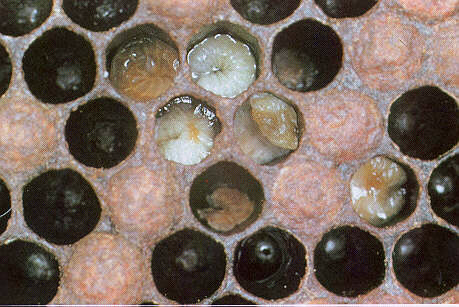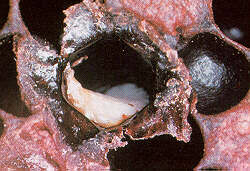European Foulbrood Disease (EFB)
We are continuing our series of honeybee diseases and parasites with another foulbrood diseases.
EUROPEAN FOULBROOD DISEASE (EFB)
EFB is also very common brood disease. However it is not as bad as the American Foulbrood (AFB) which we covered earlier. Causing agent is spore forming bacteria Melissococcus pluton. Secondary bacteria are Bacterium eurydice, Bacillus alvei, Bacillus laterasporus, Enterococcus faecalis.
European foulbrood disease affects the younger larvae in the open cells. Infected larvae changes color, die inside the open cells. Dead larvae can be removed from the cells easily. They do not stick to the bottom of the cells. It is usually seen in the spring when there is a shortage of pollen. During nectar flow worker bees clean the cells and fill them up with nectar and EFB symptoms will disappear. It may reappear in the fall. So beekeepers should check the brood and look for the disease symptoms.
Typical EFB Symptoms
- The sealed brood is not solid. Open and closed cells are mixed (Picture 1)
- Infected larvae die in open cells. (AFB infected larvae, pupae die in the sealed cells) (Pictures. 1, 2 and 3)
- Diseased larvae change color to yellow and then brown.
- Dead larvae are robbery rather than brittle and can be removed from the cells. It does not stick to the bottom of the cells (Picture 3)
- There is a sour odor like rotten meat.



How to Control and Treat EFB
- Requeen the colony with young vigorous queen. It will break the brood cycle, the new queen will lay more eggs, and colony will grow faster.
- Feed the colonies with pollen supplements during the drought seasons. Shortage of pollen or malnutrition will reduce the immune responses and larvae became more susceptible to bacterial infections)
- Can treat the colonies with oxytetracycline. (Need to get prescription from the veterinarians).
Mix 1 teaspoon (1/8 oz) of TM-25 with 3 tbs (1.5 oz) of powdered sugar, and sprinkle the mixture between the combs. This is enough for one 2 story colony. Use 2 tablespoon for a single story colony, and 1 tablespoon for a 5 frame nucleus colony. Treat the colony at least 3 times with 3-4 days intervals.
